-
 Bitcoin
Bitcoin $115000
0.12% -
 Ethereum
Ethereum $3701
4.50% -
 XRP
XRP $3.081
2.99% -
 Tether USDt
Tether USDt $0.0000
-0.01% -
 BNB
BNB $767.9
1.45% -
 Solana
Solana $169.5
3.13% -
 USDC
USDC $0.9999
0.01% -
 Dogecoin
Dogecoin $0.2106
4.30% -
 TRON
TRON $0.3334
1.62% -
 Cardano
Cardano $0.7564
2.54% -
 Stellar
Stellar $0.4165
0.76% -
 Hyperliquid
Hyperliquid $38.75
0.25% -
 Sui
Sui $3.593
3.00% -
 Chainlink
Chainlink $17.08
3.59% -
 Bitcoin Cash
Bitcoin Cash $573.6
4.35% -
 Hedera
Hedera $0.2508
-0.84% -
 Avalanche
Avalanche $23.07
6.46% -
 Ethena USDe
Ethena USDe $1.001
-0.02% -
 Litecoin
Litecoin $120.8
8.17% -
 UNUS SED LEO
UNUS SED LEO $8.943
-0.32% -
 Toncoin
Toncoin $3.400
-5.60% -
 Shiba Inu
Shiba Inu $0.00001255
1.54% -
 Uniswap
Uniswap $9.908
6.32% -
 Polkadot
Polkadot $3.718
2.10% -
 Monero
Monero $303.0
-0.74% -
 Dai
Dai $0.9999
-0.02% -
 Bitget Token
Bitget Token $4.392
0.91% -
 Cronos
Cronos $0.1403
6.31% -
 Pepe
Pepe $0.00001076
1.13% -
 Aave
Aave $267.2
1.80%
What is DeFi mining and how is it different from traditional mining?
DeFi mining offers high returns by providing liquidity to platforms like Uniswap and SushiSwap, but it comes with risks such as impermanent loss and smart contract vulnerabilities.
Apr 02, 2025 at 09:50 am
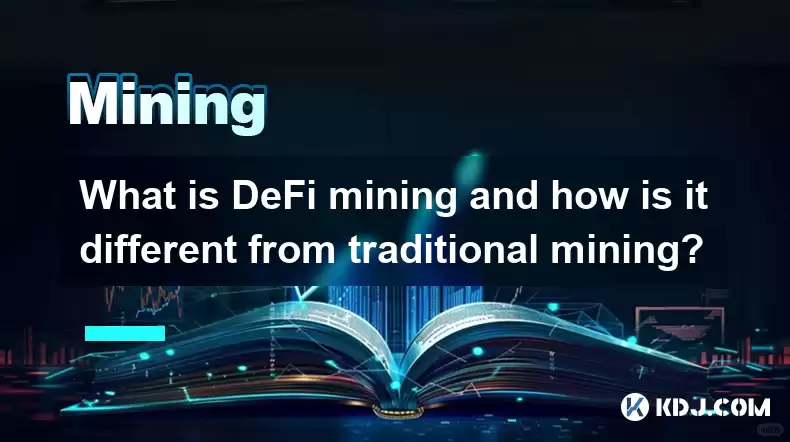
DeFi mining, also known as yield farming or liquidity mining, is a process within the decentralized finance (DeFi) ecosystem where users provide liquidity to decentralized platforms in exchange for rewards. Unlike traditional mining, which involves solving complex mathematical problems to validate transactions and add them to a blockchain, DeFi mining focuses on contributing to the liquidity of DeFi protocols. This process helps maintain the smooth operation of decentralized exchanges and lending platforms. Participants in DeFi mining typically earn tokens as rewards, which can be from the platform's native token or from other cryptocurrencies.
DeFi mining has gained significant popularity due to its potential for high returns. Users can stake their cryptocurrencies in liquidity pools, which are then used by others to trade or borrow assets. The rewards are often distributed in the form of governance tokens, which can be used to influence the future development of the platform. This model not only incentivizes participation but also helps in the decentralization of the platform's governance. However, it's important to note that DeFi mining comes with risks, such as impermanent loss and smart contract vulnerabilities.
How DeFi Mining Works
DeFi mining involves several steps that users must follow to participate and earn rewards. Here's a breakdown of the process:
- Choose a DeFi Platform: Users need to select a DeFi platform that offers liquidity mining opportunities. Popular platforms include Uniswap, SushiSwap, and Compound.
- Provide Liquidity: Users deposit their cryptocurrencies into liquidity pools. These pools are used to facilitate trading and lending on the platform.
- Earn Rewards: By providing liquidity, users earn rewards in the form of tokens. These rewards can be the platform's native token or other cryptocurrencies.
- Manage Risks: Users must be aware of the risks involved, such as impermanent loss, and take steps to mitigate them.
The rewards in DeFi mining are typically distributed based on the amount of liquidity provided and the duration of the stake. Some platforms offer additional incentives, such as bonus rewards for early participants or for providing liquidity to less popular pools.
Differences Between DeFi Mining and Traditional Mining
DeFi mining and traditional mining differ in several key aspects. Understanding these differences is crucial for anyone looking to participate in either form of mining.
- Purpose: Traditional mining is focused on securing the blockchain network by validating transactions and adding them to the blockchain. DeFi mining, on the other hand, is about providing liquidity to decentralized platforms to facilitate trading and lending.
- Process: Traditional mining involves solving complex mathematical problems using computational power. DeFi mining involves depositing cryptocurrencies into liquidity pools.
- Rewards: In traditional mining, miners are rewarded with newly minted coins and transaction fees. In DeFi mining, participants earn tokens as rewards for providing liquidity.
- Risks: Traditional mining carries risks such as high energy costs and hardware depreciation. DeFi mining involves risks like impermanent loss and smart contract vulnerabilities.
- Accessibility: Traditional mining often requires significant investment in hardware and electricity. DeFi mining is more accessible, as it only requires users to have cryptocurrencies to deposit into liquidity pools.
Benefits of DeFi Mining
DeFi mining offers several benefits that have contributed to its growing popularity within the cryptocurrency community.
- High Potential Returns: DeFi mining can offer high returns, especially during the early stages of a platform's launch. This attracts many users looking to maximize their earnings.
- Accessibility: Unlike traditional mining, which requires specialized hardware, DeFi mining is accessible to anyone with cryptocurrencies. This democratizes the opportunity to earn rewards.
- Decentralization: By participating in DeFi mining, users contribute to the decentralization of the platform's governance. This aligns with the broader goals of the DeFi movement.
- Flexibility: Users can choose from a variety of platforms and liquidity pools, allowing them to tailor their participation to their risk tolerance and investment goals.
However, it's important for users to conduct thorough research and understand the risks involved before participating in DeFi mining. The potential for high returns comes with the possibility of significant losses, especially in volatile market conditions.
Risks Associated with DeFi Mining
While DeFi mining offers attractive rewards, it also comes with several risks that users must be aware of.
- Impermanent Loss: This occurs when the price of the tokens in the liquidity pool changes after a user has deposited them. If the price change is significant, the user may end up with fewer tokens upon withdrawal than if they had simply held onto them.
- Smart Contract Vulnerabilities: DeFi platforms rely on smart contracts, which can have bugs or be exploited by hackers. This can lead to the loss of deposited funds.
- Volatility: The cryptocurrency market is highly volatile, and the value of the rewards earned through DeFi mining can fluctuate significantly.
- Regulatory Risks: The regulatory environment for DeFi is still evolving, and changes in regulations could impact the viability of DeFi mining.
Users must carefully assess these risks and consider strategies to mitigate them, such as diversifying their investments and staying informed about the latest developments in the DeFi space.
Examples of DeFi Mining Platforms
Several platforms have emerged as leaders in the DeFi mining space, each offering unique features and rewards.
- Uniswap: One of the most popular decentralized exchanges, Uniswap allows users to provide liquidity and earn UNI tokens as rewards. It's known for its simplicity and wide range of supported tokens.
- SushiSwap: A fork of Uniswap, SushiSwap offers similar liquidity mining opportunities but with additional features like yield farming and staking. Users can earn SUSHI tokens as rewards.
- Compound: A decentralized lending platform, Compound allows users to supply assets to liquidity pools and earn COMP tokens. It's known for its focus on lending and borrowing.
- Curve Finance: Specializing in stablecoin trading, Curve Finance offers liquidity mining opportunities for users who provide stablecoins to its pools. Users can earn CRV tokens as rewards.
Each of these platforms has its own set of rules and rewards structures, so users should research and compare them before deciding where to participate in DeFi mining.
Strategies for Successful DeFi Mining
To maximize the benefits of DeFi mining while minimizing the risks, users can employ several strategies.
- Diversify Liquidity Pools: By spreading their investments across multiple liquidity pools, users can reduce the impact of impermanent loss and volatility.
- Stay Informed: Keeping up with the latest news and developments in the DeFi space can help users make informed decisions about which platforms to participate in and when to adjust their strategies.
- Use Risk Management Tools: Some platforms offer tools to help users manage their risks, such as stop-loss orders or insurance products. Utilizing these tools can help protect against potential losses.
- Monitor Rewards and Fees: Users should regularly review the rewards they are earning and the fees they are paying to ensure that their participation remains profitable.
By following these strategies, users can enhance their chances of success in DeFi mining and navigate the complexities of the DeFi ecosystem more effectively.
The Future of DeFi Mining
The future of DeFi mining looks promising, with continued growth and innovation expected in the DeFi space. As more platforms emerge and existing ones evolve, the opportunities for users to participate in DeFi mining are likely to expand.
- Increased Adoption: As more people become aware of the potential benefits of DeFi mining, adoption is expected to grow. This could lead to more liquidity and higher rewards for participants.
- Regulatory Developments: The regulatory landscape for DeFi is still evolving, and future regulations could impact the viability and structure of DeFi mining. Users should stay informed about these developments.
- Technological Advancements: Advances in blockchain technology and smart contract development could lead to more secure and efficient DeFi platforms, enhancing the overall experience for users.
- Integration with Traditional Finance: As DeFi continues to mature, there may be opportunities for integration with traditional financial systems, potentially bringing more stability and mainstream acceptance to DeFi mining.
The dynamic nature of the DeFi space means that users must remain adaptable and ready to adjust their strategies as the landscape evolves.
Common Questions About DeFi Mining
Q: What is DeFi mining?
A: DeFi mining, also known as yield farming or liquidity mining, is a process where users provide liquidity to decentralized platforms in exchange for rewards. These rewards are typically in the form of tokens and help maintain the smooth operation of decentralized exchanges and lending platforms.
Q: How is DeFi mining different from traditional mining?
A: DeFi mining focuses on providing liquidity to decentralized platforms, while traditional mining involves solving complex mathematical problems to validate transactions and add them to a blockchain. DeFi mining rewards users with tokens for providing liquidity, whereas traditional mining rewards miners with newly minted coins and transaction fees.
Q: What are the benefits of DeFi mining?
A: The benefits of DeFi mining include high potential returns, accessibility to anyone with cryptocurrencies, contribution to the decentralization of platform governance, and flexibility in choosing platforms and liquidity pools.
Q: What are the risks associated with DeFi mining?
A: The risks of DeFi mining include impermanent loss, smart contract vulnerabilities, market volatility, and regulatory uncertainties. Users must carefully assess these risks and consider strategies to mitigate them.
Q: Can you provide examples of DeFi mining platforms?
A: Examples of DeFi mining platforms include Uniswap, SushiSwap, Compound, and Curve Finance. Each platform offers unique features and rewards structures for users participating in liquidity mining.
Q: What strategies can be used for successful DeFi mining?
A: Strategies for successful DeFi mining include diversifying liquidity pools, staying informed about the latest developments, using risk management tools, and monitoring rewards and fees to ensure profitability.
Q: What does the future hold for DeFi mining?
A: The future of DeFi mining looks promising with increased adoption, regulatory developments, technological advancements, and potential integration with traditional finance. Users should remain adaptable as the DeFi landscape evolves.
Disclaimer:info@kdj.com
The information provided is not trading advice. kdj.com does not assume any responsibility for any investments made based on the information provided in this article. Cryptocurrencies are highly volatile and it is highly recommended that you invest with caution after thorough research!
If you believe that the content used on this website infringes your copyright, please contact us immediately (info@kdj.com) and we will delete it promptly.
- Solana Memecoin Launchpads: A Wild Ride with LetsBONK.fun Leading the Charge
- 2025-08-05 17:30:12
- Crypto Volatility & Token Unlocks: Navigating the Storm
- 2025-08-05 16:30:13
- SUI Traders Eye Discount: Is Now the Time to Buy?
- 2025-08-05 16:30:13
- Bitcoin Price in August: Will the BTC Rally Continue?
- 2025-08-05 17:35:12
- Decentralized Perpetuals Soar: Volume Hits All-Time High, Leaving CEXs in the Dust?
- 2025-08-05 16:50:12
- Decoding MYCUSD: Crypto Forecasting for Digital Asset Success
- 2025-08-05 16:50:12
Related knowledge
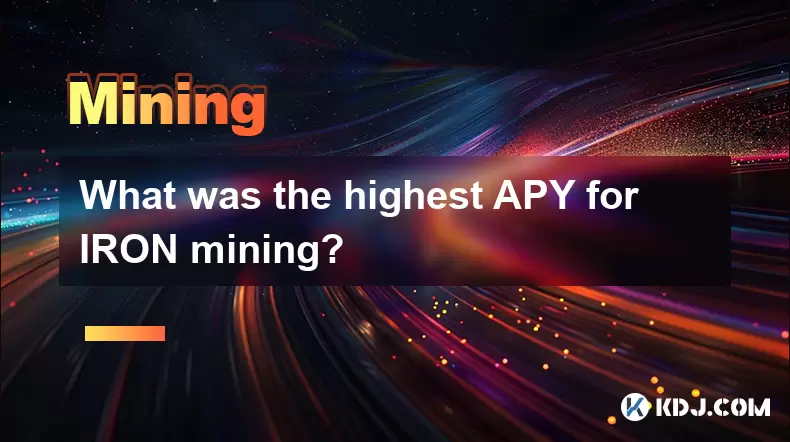
What was the highest APY for IRON mining?
Jul 23,2025 at 05:14am
Understanding IRON Token and Its Mining MechanismThe IRON token is a stablecoin that operates within the Iron Finance ecosystem, primarily on blockcha...

What is impermanent loss in IRON pools?
Jul 23,2025 at 09:00am
Understanding Impermanent Loss in the Context of IRON PoolsImpermanent loss is a phenomenon that affects liquidity providers in decentralized finance ...
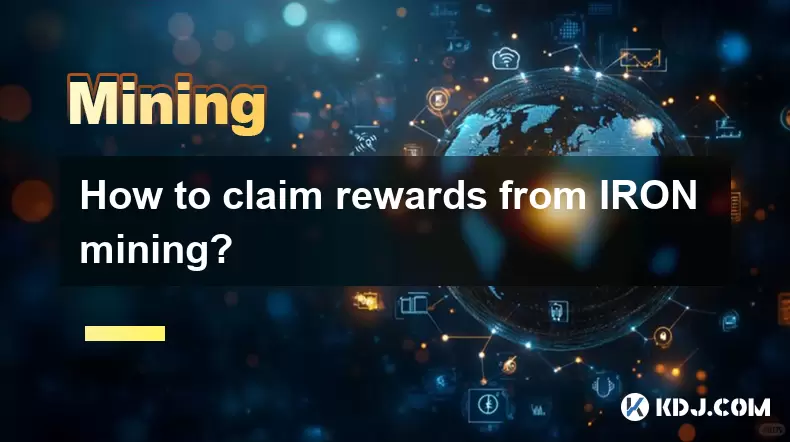
How to claim rewards from IRON mining?
Jul 23,2025 at 02:21pm
Understanding IRON Mining and Reward MechanismsIRON Finance operated as a decentralized finance (DeFi) protocol on the Polygon and Binance Smart Chain...
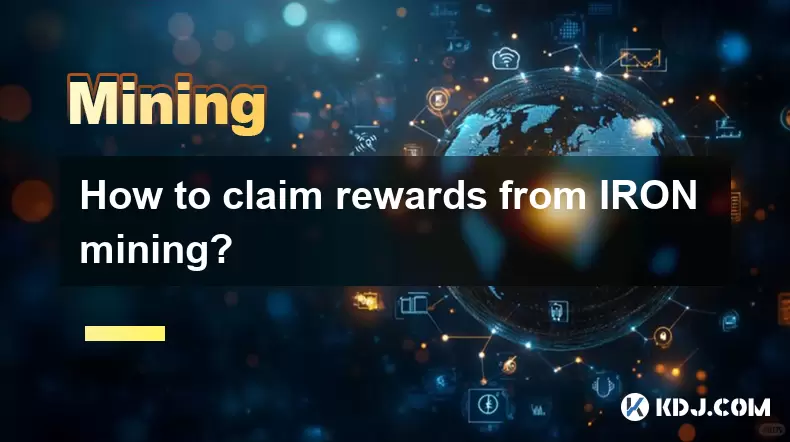
How to claim rewards from IRON mining?
Jul 29,2025 at 05:07am
Understanding IRON Mining and Reward MechanismIRON is a dual-token system designed to stabilize the value of a synthetic asset through a combination o...

IRON mining tutorial for beginners
Jul 27,2025 at 12:01am
What Is IRON and How Does It Work in the Cryptocurrency Ecosystem?IRON is a cryptocurrency token that operates on the Binance Smart Chain (BSC) and is...
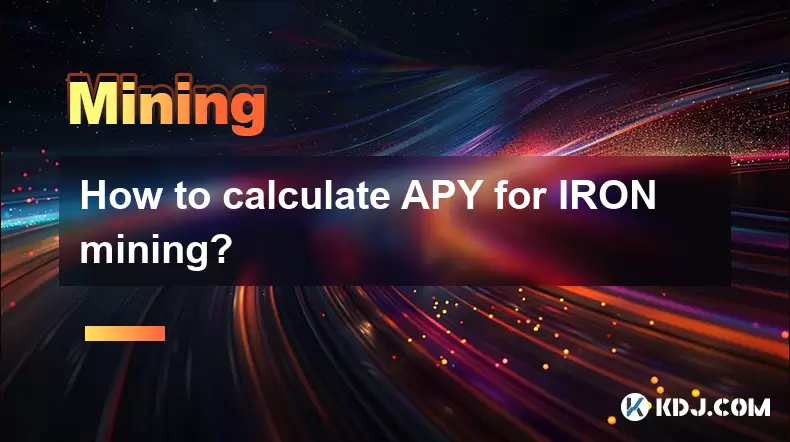
How to calculate APY for IRON mining?
Jul 28,2025 at 09:49am
Understanding APY in the Context of IRON Token MiningWhen engaging in IRON token mining within decentralized finance (DeFi) platforms, Annual Percenta...

What was the highest APY for IRON mining?
Jul 23,2025 at 05:14am
Understanding IRON Token and Its Mining MechanismThe IRON token is a stablecoin that operates within the Iron Finance ecosystem, primarily on blockcha...

What is impermanent loss in IRON pools?
Jul 23,2025 at 09:00am
Understanding Impermanent Loss in the Context of IRON PoolsImpermanent loss is a phenomenon that affects liquidity providers in decentralized finance ...

How to claim rewards from IRON mining?
Jul 23,2025 at 02:21pm
Understanding IRON Mining and Reward MechanismsIRON Finance operated as a decentralized finance (DeFi) protocol on the Polygon and Binance Smart Chain...

How to claim rewards from IRON mining?
Jul 29,2025 at 05:07am
Understanding IRON Mining and Reward MechanismIRON is a dual-token system designed to stabilize the value of a synthetic asset through a combination o...

IRON mining tutorial for beginners
Jul 27,2025 at 12:01am
What Is IRON and How Does It Work in the Cryptocurrency Ecosystem?IRON is a cryptocurrency token that operates on the Binance Smart Chain (BSC) and is...

How to calculate APY for IRON mining?
Jul 28,2025 at 09:49am
Understanding APY in the Context of IRON Token MiningWhen engaging in IRON token mining within decentralized finance (DeFi) platforms, Annual Percenta...
See all articles

























































































